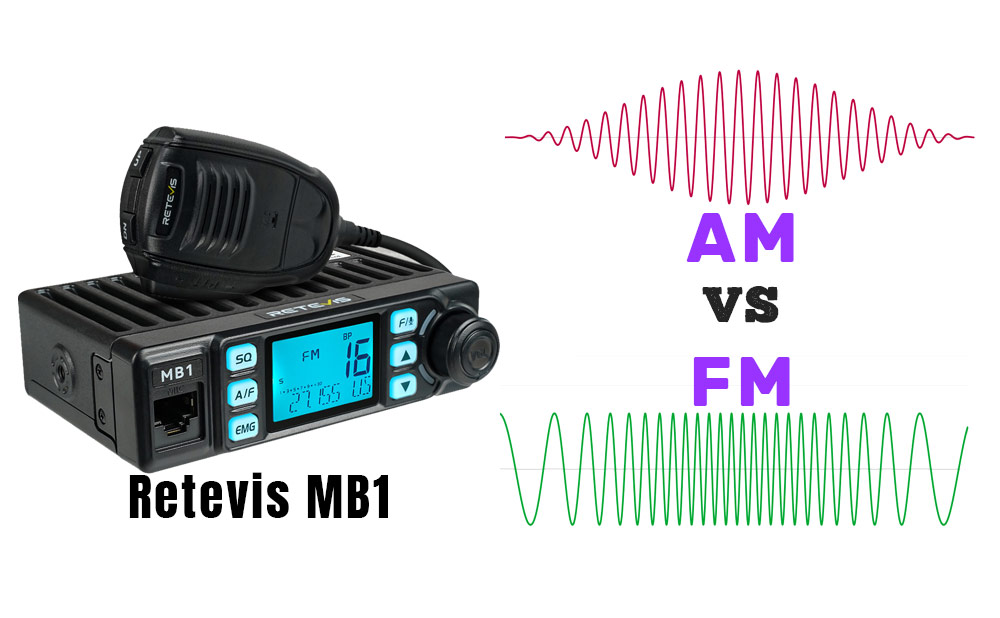Should CB radio be on FM or AM mode?

Should CB radio be on FM or AM mode?
AM (or Amplitude Modulation) and FM (or Frequency Modulation) are ways of broadcasting radio signals. Both transmit the information in the form of electromagnetic waves. AM works by modulating (varying) the amplitude of the signal or carrier transmitted according to the information being sent, while the frequency remains constant. This differs from FM technology in which information (sound) is encoded by varying the frequency of the wave and the amplitude is kept constant.
AM vs FM - Difference and Comparison
AM vs FM waveforms

Feature Comparison chart
| AM | FM | |
| Stands for | AM stands for Amplitude Modulation | FM stands for Frequency Modulation |
| Origin | AM method of audio transmission was first successfully carried out in the mid 1870s. | FM radio was developed in the United states in the 1930s, mainly by Edwin Armstrong. |
| Modulating differences | In AM, a radio wave known as the "carrier" or "carrier wave" is modulated in amplitude by the signal that is to be transmitted. The frequency and phase remain the same. | In FM, a radio wave known as the "carrier" or "carrier wave" is modulated in frequency by the signal that is to be transmitted. The amplitude and phase remain the same. |
| Pros and cons | AM has poorer sound quality compared with FM, but is cheaper and can be transmitted over long distances. It has a lower bandwidth so it can have more stations available in any frequency range. | FM is less prone to interference than AM. However, FM signals are impacted by physical barriers. FM has better sound quality due to higher bandwidth. |
| Frequency Range | AM radio ranges from 535 to 1705 KHz (OR) Up to 1200 bits per second. | FM radio ranges in a higher spectrum from 88 to 108 MHz. (OR) 1200 to 2400 bits per second. |
| Bandwidth Requirements | Twice the highest modulating frequency. In AM radio broadcasting, the modulating signal has bandwidth of 15kHz, and hence the bandwidth of an amplitude-modulated signal is 30kHz. | Twice the sum of the modulating signal frequency and the frequency deviation. If the frequency deviation is 75kHz and the modulating signal frequency is 15kHz, the bandwidth required is 180kHz. |
| Zero crossing in modulated signal | Equidistant | Not equidistant |
| Complexity | Transmitter and receiver are simple but syncronization is needed in case of SSBSC AM carrier. | Tranmitter and reciver are more complex as variation of modulating signal has to beconverted and detected from corresponding variation in frequencies.(i.e. voltage to frequency and frequency to voltage conversion has to be done). |
| Noise | AM is more susceptible to noise because noise affects amplitude, which is where information is "stored" in an AM signal. | FM is less susceptible to noise because information in an FM signal is transmitted through varying the frequency, and not the amplitude. |
Should my CB be on AM or FM mode?
The mode you should select for CB communication depends on your needs and the distance between users.
The main advantage of AM for CB is longer range. If you’re trying to communicate with other CB users at greater distances, AM frequencies will likely be more reliable.
FM mode offers better audio quality for CB users and is easy to use. It offers clear, noise-free, and more intelligible two-way communications versus AM, which is why FM is popular with CB users in other countries and in other radio bands. FM mode also greatly reduces background noise and interference.
Having a dual mode AM/FM CB radio, such as the Retevis MB1, provides the flexibility to choose the modulation mode that best suits your communication needs. With this dual mode capability, you can easily switch between AM and FM modes based on the clarity and intelligibility of the signal received. For example, if you encounter muffled sound while listening in AM mode, switching to FM mode might provide a clear and intelligible communication experience.
It's important to note that selecting the appropriate modulation mode may require some trial and error, as different circumstances may call for different modes. The versatility of a dual mode CB radio allows you to adapt to various communication scenarios and ensure effective communication with other stations.
In conclusion, AM and FM are two distinct methods of transmitting radio signals, each with its own advantages and considerations. When choosing a CB radio, consider your communication needs, desired range, and audio quality. A dual mode AM/FM CB radio, like the Retevis MB1, offers the best of both worlds, allowing you to switch between modes and optimize your communication experience.






